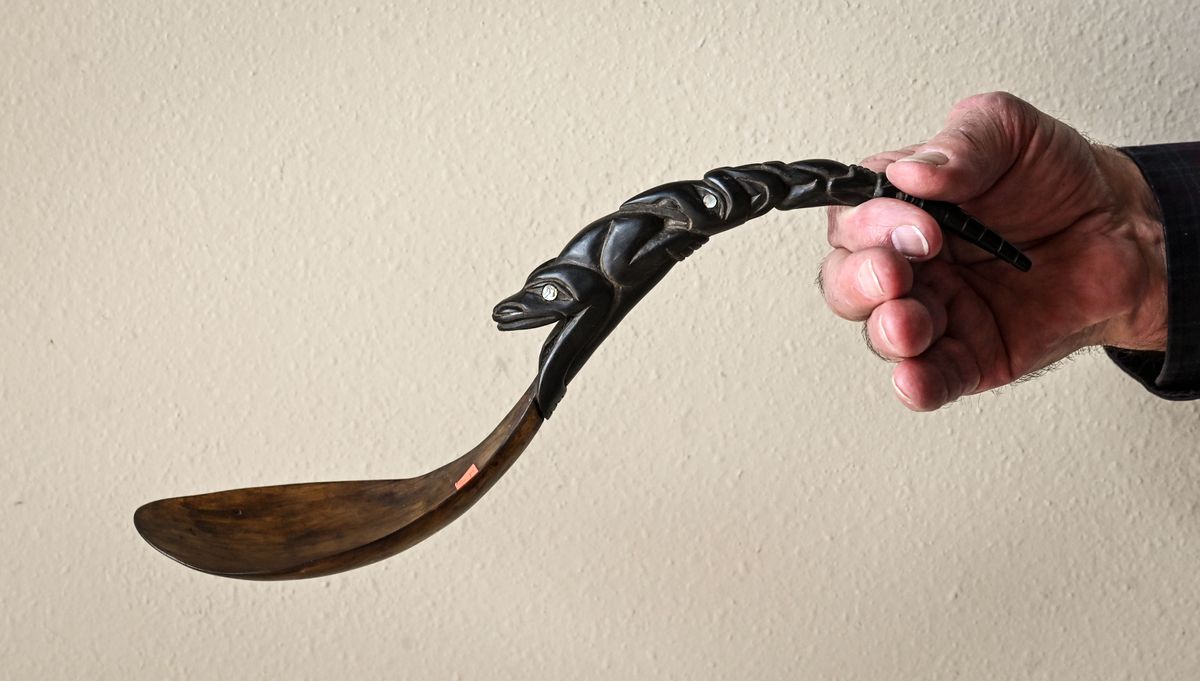The Collector: Bruce Ottmar intrigued by Pacific Northwest and Alaska Native artifacts

It started with the arrowheads he found with his dad near Vantage, Washington, and grew to include artifacts dug from the permafrost on St. Lawrence Island in the Bering Sea.
Bruce Ottmar’s fascination with indigenous cultures led to his collection of items from the distant past.
“Dad liked arrowheads,” recalled Ottmar. “When I was a child we’d go dig for them down near Vantage before the (Wanapum) Dam went in.”
The area around Vantage has been occupied by the Wanapum Native Americans for thousands of years, and he relished finding evidence of ancient civilizations with his dad.
In his home in north Spokane, he displayed a selection of chert, flint and obsidian arrowheads he had found as a child.
He grew up in Davenport, Washington, and an artifact found near his hometown is a sentimental favorite. Ottmar pointed to a bone with three distinct sections.
“Our neighbor was digging his basement north of Davenport and found this and called WSU,” he said. “They came out and dated it. But I’m not sure if it’s Mammoth or Mastodon toe.”
After earning a degree in industrial arts from Eastern Washington University, Ottmar embarked on a 29-year teaching career in Medical Lake and that’s when he began collecting in earnest.
While attending a gun show he heard about artifacts found in the permafrost on St. Lawrence Island. The island is thought to be one of the last exposed portions of the land bridge that once joined Asia with North America during the Pleistocene Epoch (Ice Age).
Currently, it’s inhabited mostly by Siberian Yupik. As a result of having title to the land, the Yupik are legally able to sell the fossilized ivory and other artifacts found on the island. Objects dug from the permafrost are remarkably well-preserved.
Ottmar pulled an example from a cabinet – a fishing gaff. With a wooden handle notched to fit the user’s fingers and a piece of walrus ivory fastened to it with hide, it must have been a vital tool for the ancient human who wielded it.
Other items from St. Lawrence Island include a delicate ivory fishhook, a hide scraper and pieces of harpoons.
He held out two additional objects.
“This is a lady’s boning knife,” he said, sliding a compact slate blade from its bone handle. “She does the slicing of the fish.”
By contrast, the larger knife with its wooden handle and slate blade likely belonged to a man.
Antiquities from St. Lawrence Island are expensive, and Ottmar soon set his eyes on things from mainland Alaska.
He cradled one of his favorite items in his hand – small Baleen basket. Baleen basketry is an Alaska Native art developed in Utqiagvik, Point Hope, and Wainwright, by the North Alaskan Iñupiaq people at the dawn of the 20th century. The baskets made with baleen (a flexible material found in the mouths of Baleen whales) were based on willow-root prototypes. Thin strips of baleen are cut and attached to ivory disks at the start. A coiling method is used to sew the bands together, ending with a carved ivory knob on the handle.
Ottmar has employed his own creativity, as well. He displayed a large piece of a Baleen whale’s jaw and pointed to the engraving at one end.
“I did the scrimshaw.”
Like many collectors choosing a favorite item proves problematic. There’s an intricately carved horn spoon or ladle, studded with bits of abalone and a large whale vertebrae with carvings on the front and back.
“The joy for me is looking at the objects,” he said. “They are things I like.”
His collection also included objects that aren’t necessarily ancient, but still quite old.
A pair of well-worn caribou mukluks, native pipes carved from pipestone, a hat woven from cedar that kept the head of its wearer protected from rain and snow. The fascination with ancient history that sparked while finding arrowheads with his dad still burns.
Ottmar ran his fingers along the edge of the ancient fishing gaff.
“I would love to meet its maker and learn how they carved these things.”